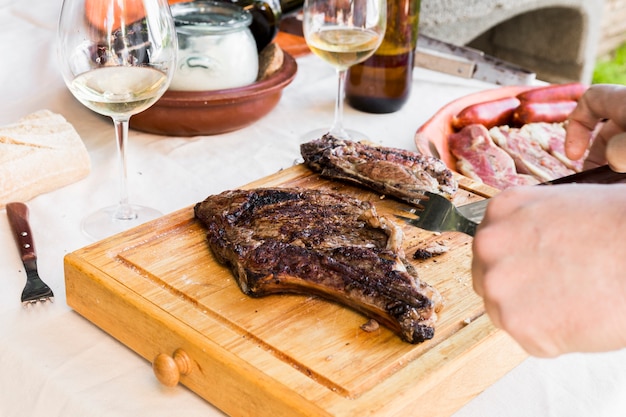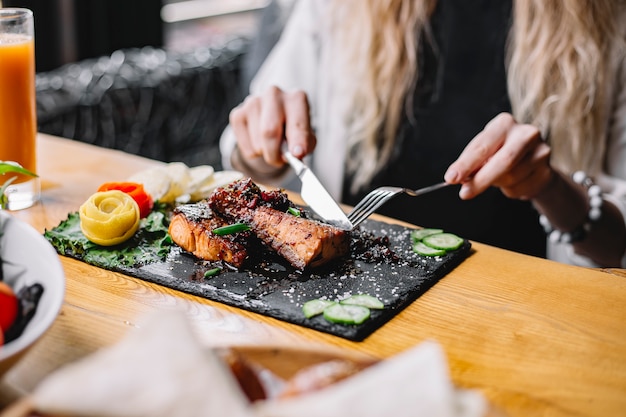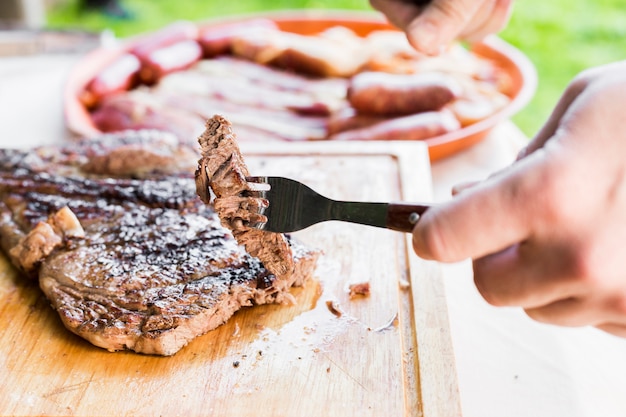(Part 1) The Cuts

Unveiling the Rib Roast Family
Rib roasts come in a few different forms, each with its own unique charm. Let's break them down:
- standing rib roast: The king of the rib roast family. It's a masterpiece with the ribs intact, creating a breathtaking presentation. It's typically cooked bone-in, boasts a robust flavour, and is ideal for grand gatherings. Be warned, though – it can be a bit of a beast!
- Rib Roast (Boneless): You get the same fantastic rib flavour, but without the bone. This makes it a bit easier to manage and slice, perfect for smaller families or those who prefer a simpler roast.
- prime rib: This prized cut comes from the rib primal, encompassing the first three ribs. It's renowned for its rich marbling and melt-in-your-mouth tenderness. This is the quintessential rib roast, the one that evokes visions of lavish feasts.
- Rib Eye Roast: Hailing from the middle section of the rib primal, this cut offers a slightly more budget-friendly option without sacrificing the buttery texture.
Choosing Your Rib Roast Champion
The perfect cut really depends on your personal preferences and the occasion. For a big family gathering, a standing rib roast will command attention and provide ample servings. A boneless rib roast is a wonderful choice for a more intimate gathering or a weeknight meal. As for me? I'm a sucker for a standing rib roast. It's a statement piece! But for everyday enjoyment, a boneless rib roast is my go-to.
Quality is King
Listen, you're going to want to splurge on a quality piece of beef for your rib roast. It's an investment that'll pay off in spades. Look for cuts with generous marbling – those streaks of fat running through the meat. This fat melts during cooking, adding incredible flavour and tenderness.
(Part 2) The Art of Preparation

Trimming and Seasoning for Success
Once you've got your prized rib roast in hand, it's time to get down to business. The first step is trimming away any excess fat. Don't go overboard, though – we want that delicious fat to infuse the meat with flavour. Aim for a ??-inch layer of fat. This ensures even cooking and prevents a greasy outcome.
Now, onto the exciting part: seasoning! This is where you get to showcase your culinary creativity. Salt and pepper are the classic combination, a must-have for any rib roast. I like to add a dash of garlic powder and onion powder for an extra kick of flavour. Don't be afraid to experiment with other spices – rosemary, thyme, paprika, even a touch of chili powder for a hint of heat! Remember, you want the seasonings to penetrate the meat, so be generous with your salting. I usually season the roast the day before, leaving it uncovered in the fridge. This allows the salt to draw out moisture and then reabsorb it, resulting in a more tender and flavourful roast.
Preparing for Oven Time
Before your rib roast embarks on its journey in the oven, it needs a little TLC. This might involve tying it with kitchen twine to help it cook evenly or using a roasting rack to promote airflow. I'm a big fan of the roasting rack – it encourages the fat to render, creating a beautiful, crispy exterior.
(Part 3) Unlocking Cooking Methods

The Oven: A Classic Approach
The most tried-and-true method for cooking a rib roast is in the oven. It's simple, reliable, and consistently produces a stunning result. The key lies in cooking it low and slow, allowing the fat to melt and the meat to achieve that melt-in-your-mouth tenderness. For a standing rib roast, aim for a temperature of 325°F (160°C), while a boneless rib roast thrives at 350°F (175°C). The cooking time will depend on the size of your roast – expect a 3-4 pound rib roast to take about 2-3 hours. Don't rely solely on time, though. Always use a meat thermometer to guarantee your roast is cooked to your exact preference.
reverse searing: The Adventurous Choice
For those seeking a more adventurous approach, there's the reverse searing method. This involves cooking the roast at a low temperature for a longer period, followed by a rapid sear at a high temperature. This method promotes even cooking throughout the roast while creating a mouthwatering crust.
Grilling: Embracing the Outdoors
If you're lucky enough to have a grill, why not take your rib roast outdoors? It's a fantastic way to infuse your roast with smoky flavour and achieve a delectable char on the exterior. Just make sure you've got a high-quality grill and enough space to accommodate your roast.
(Part 4) Navigating Cooking Time and Temperature
The Importance of Temperature
Cooking your rib roast to the perfect temperature is paramount. Overcook it, and you'll end up with a tough, dry roast. Undercook it, and well, you might be taking a chance with food safety. The USDA recommends an internal temperature of 145°F (63°C) for medium-rare. However, everyone has their preferences, so feel free to adjust the temperature accordingly. Here's a handy chart to guide you:
| Doneness | Internal Temperature (°F) | Internal Temperature (°C) |
|---|---|---|
| Rare | 125-130 | 52-54 |
| Medium-Rare | 130-135 | 54-57 |
| Medium | 140-145 | 60-63 |
| Medium-Well | 150-155 | 65-68 |
| Well-Done | 160 | 71 |
Doneness and the Art of Resting
Once your rib roast reaches your desired temperature, it's time to take it out of the oven. But don't carve it just yet! Let it rest for at least 15 minutes before carving. This crucial step allows the juices to redistribute throughout the meat, resulting in a tender and juicy masterpiece. I often cover the roast with foil during this time to keep it warm and prevent it from drying out.
(Part 5) The Art of Carving a Rib Roast
Presenting a Culinary Masterpiece
Carving a rib roast is a bit of a performance, a chance to show off your culinary prowess. A sharp knife is essential for clean, even cuts. For a standing rib roast, start by removing the bones. You can use a meat cleaver or a heavy-duty knife for this task. Once the bones are out of the way, you can slice the roast into individual portions. For a boneless rib roast, simply slice it into thin, even slices.
Completing the Culinary Symphony
Now you've got a beautiful, perfectly cooked rib roast. What to serve it with? The possibilities are endless! But here are a few of my personal favourites:
- Roasted Vegetables: A classic pairing for a rib roast. I love the combination of roasted potatoes, carrots, and onions. The sweetness of the carrots and onions perfectly complements the rich flavour of the beef.
- Yorkshire Pudding: This fluffy, savory batter is the ultimate companion to a rib roast. Its airy texture provides a delightful contrast to the rich, juicy meat.
- Creamy Gravy: Made with the pan drippings, this gravy is a must-have for any rib roast. It captures all the delicious flavours of the cooking process, creating a truly decadent sauce.
- green bean casserole: A Thanksgiving staple, this casserole is delicious year-round! The creamy sauce and crispy fried onions offer a wonderful contrast to the rich rib roast.
- mashed potatoes: A comforting and crowd-pleasing side dish that complements the richness of the roast perfectly.
(Part 6) FAQs – Your Rib Roast Queries Answered
1. How do I know when my rib roast is done?
The best way to determine doneness is by using a meat thermometer. Insert the thermometer into the thickest part of the roast, ensuring it's not touching any bone. Let it sit for a few seconds, then check the reading against the doneness chart above.
2. Can I cook a rib roast in a slow cooker?
While you can technically cook a rib roast in a slow cooker, it's not the ideal method. The slow cooker environment doesn't provide enough heat to render the fat properly, which can lead to a tough, chewy result.
3. Can I freeze a rib roast?
Absolutely! Wrap your rib roast tightly in plastic wrap and then in foil or freezer paper. It will keep in the freezer for up to 3 months. To thaw it, simply move it from the freezer to the refrigerator 2-3 days before you plan to cook it.
4. What if my rib roast is overcooked?
Don't panic! Even an overcooked rib roast can still be salvaged. It might be a bit more firm than you intended, but it's still edible.
5. What do I do with leftover rib roast?
The best part? Leftover rib roast is even better the next day! Slice it thin and use it on sandwiches, salads, or even create a hearty shepherd's pie.
(Part 7) Tips for Rib Roast Triumph
Unlocking Rib Roast Mastery
Here are some extra tips to help you achieve rib roast perfection:
- Bring it to Room Temperature: Before you pop your roast in the oven, take it out of the fridge and let it sit at room temperature for 30-60 minutes. This helps the meat cook more evenly.
- Give It Space: Make sure your oven isn't overcrowded. Your rib roast needs room to breathe and circulate air.
- Embrace the Roasting Rack: A roasting rack is a great tool for encouraging the fat to render and ensuring even cooking.
- Baste for Extra Flavor: Basting the roast with pan drippings helps keep it moist and adds extra flavour.
- The Importance of Resting: Once the roast is cooked, let it rest for at least 15 minutes before carving. This allows the juices to redistribute, resulting in a more tender and juicy roast.
(Part 8) The Rib Roast Journey
Cooking a rib roast is more than just preparing a meal – it's an experience. It's a journey from the butcher shop to your kitchen, from the sizzling pan to the tantalizing aroma filling your home, and finally, to the satisfaction of a perfectly cooked masterpiece. It's a journey that brings people together, a journey worth savouring.
So, go on, embrace the challenge! Experiment, learn, and most importantly, enjoy the process. After all, that's what cooking is all about. Who knows? You might even discover your own secret recipe for the perfect rib roast.
Everyone is watching

Corn on the Cob: The Ultimate Guide to Perfectly Cooked Ears
Healthy MealsAh, corn on the cob. Just the name evokes images of sunny days, barbecues, and that sweet, juicy flavour that ...

Scallops: The Ultimate Guide to Perfect Cooking
Healthy MealsAh, scallops. Those delicate, sweet, and utterly delicious morsels of the sea. They hold a special place in my...

Spaghetti Squash: The Ultimate Guide to Cooking and Serving
Healthy MealsRemember that time you saw spaghetti squash at the supermarket, looking all bumpy and strange, and thought, "W...

Salmon Cooking Times: Perfect Guide for Every Recipe
Healthy MealsLet me tell you, cooking salmon is an art form. It's all about getting that perfect balance: juicy and tender,...

Ham Cooking Time: How Long to Bake, Smoke, or Boil a Delicious Ham
Healthy MealsAh, ham. It's a classic, isn't it? A real crowd-pleaser, especially around holidays. And when done right, it'...
